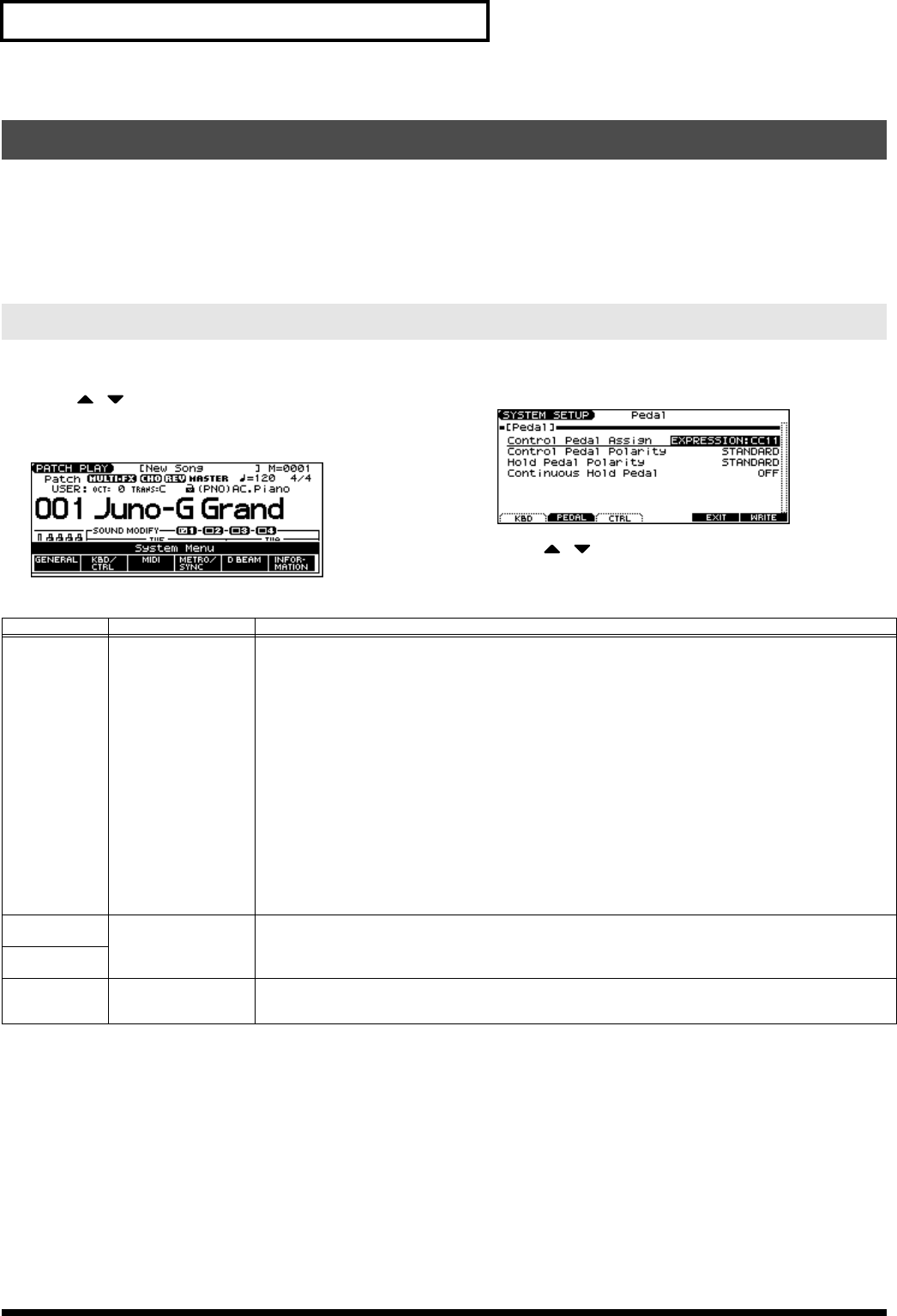
72
Modifying the Sound in Real Time
You can modify the sound by pressing a pedal that is connected to
the rear panel HOLD PEDAL jack or CONTROL PEDAL jack.
Pedal such as expression pedals (EV-5; available separately), pedal
switches (DP series; available separately), or foot switches (BOSS FS-
5U; available separately) can be connected to the JUNO-G.
1.
Access the Patch Play screen (p. 25).
2.
While playing the keyboard to produce sound, operate a
pedal.
The sound will change according to the function that is assigned
to the control pedal.
1.
Press EDIT [MENU].
2.
Press [ ] [ ] to select “2. System,” and then press
[ENTER].
The System Menu window appears.
3.
Press [F2 (KBD/CTRL)], and then press [F2 (PDL BND)].
A screen like the following appears.
4.
Press [ ] [ ] to select the parameter.
5.
Use the VALUE dial or [INC] [DEC] to make the setting.
6.
If you want to save the settings, press [F6 (WRITE)].
7.
Press [EXIT] to return to the previous screen.
Control Pedal
Control Pedal Settings
Parameter
Value Explanation
Control Pedal
Assign
CC01–31, 33–95,
BEND UP,
BEND DOWN,
AFTERTOUCH,
OCT UP,
OCT DOWN,
START/STOP,
PUNCH IN/OUT,
TAP TEMPO,
PROG UP,
PROG DOWN,
FAVORITE UP,
FAVORITE DOWN,
ARP SW,
RHY START/STOP,
CHORD SW,
LIVE SET UP,
LIVE SET DOWN,
LOOP
Function of the pedal connected to the CONTROL PEDAL jack
CC01–31, 33–95:
Controller numbers 1–31, 33–95
BEND UP:
Controls the pitch as specified by the “Pitch Bend Range Up” setting (p. 37).
BEND DOWN:
Controls the pitch as specified by the “Pitch Bend Range Down” setting (p. 37).
AFTERTOUCH:
Aftertouch
OCT UP:
Pedal press raises the key range in octave steps (up to 3 octaves higher).
OCT DOWN:
Pedal press lowers the key range in octave steps (up to 3 octaves lower).
START/STOP:
The song recorder will start/stop.
PUNCH IN/OUT:
Manual punch-in/out recording will start/stop.
TAP TEMPO:
Tap tempo (a tempo specified by the interval at which you press the pedal).
PROG UP:
The next sound number will be selected.
PROG DOWN:
The previous sound number will be selected.
FAVORITE UP:
The favorite patch/performance of the next number or bank will be selected.
FAVORITE DOWN:
The favorite patch/performance of the previous number or bank will be selected.
ARP SW:
Arpeggio/Rhythm function on/off
RHY START/STOP:
Rhythm pattern playback on/off
CHORD SW:
Switches the Chord Memory function on/off.
LIVE SET UP:
Switches to the next step within a Live Setting list.
LIVE SET DOWN:
Switches to the previous step within a Live Setting list.
LOOP:
Loop Playback on/off
Control Pedal
Polarity
STANDARD,
REVERSE
Polarity of the pedal
On some pedals, the electrical signal output by the pedal when it is pressed or released is the opposite of other ped-
als. If your pedal has an effect opposite of what you expect, set this parameter to “REVERSE.” If you are using a
Roland pedal (that has no polarity switch), set this parameter to “STANDARD.”
Hold Pedal Po-
larity
Continuous
Hold Pedal
OFF, ON Determines whether the HOLD PEDAL jack will provide support for half-pedaling (ON), or not (OFF).
When this is set to “ON,” you can then connect an optional damper pedal (DP-10, etc.), and employ pedal work to
achieve even finer control in performances in which piano tones are used.
JUNO-G_e.book 72 ページ 2006年2月13日 月曜日 午後2時44分


















